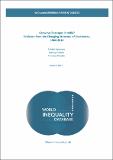Growing cleavages in India? Evidence from the changing structure of electorates, 1962–2014
Author(s)
Banerjee, Abhijit; Gethin, Amory; Piketty, Thomas
DownloadSubmitted version (1.658Mb)
Terms of use
Metadata
Show full item recordAbstract
This paper combines surveys, election results and social spending data to document a long-run evolution of political cleavages in India. The transition from a dominant-party system to a fragmented system characterised by several smaller regionalist parties and, more recently, the Bharatiya Janata Party, coincides with the rise of religious divisions and the persistence of strong caste-based cleavages, while education, income and occupation play a diminishing role (controlling for caste) in determining voters’ choices. More importantly, there is no evidence of the new party system of being associated with changes in social policy, which corroborates the fact that in India, as in many Western democracies, political conflicts are increasingly focused on identity and religious–ethnic conflicts rather than on tangible material benefits and class-based redistribution. ©2019
Date issued
2019Department
Massachusetts Institute of Technology. Department of EconomicsJournal
World Inequality Lab working paper
Publisher
World Inequality Lab
Citation
Banerjee, Abhijit, Amory Gethin, and Thomas Piketty. Growing Cleavages in India? Evidence from the Changing Structure of Electorates, 1962-2014. World Inequality Lab working paper 2019, 5 (2019) ©2019 Author(s)
Version: Original manuscript